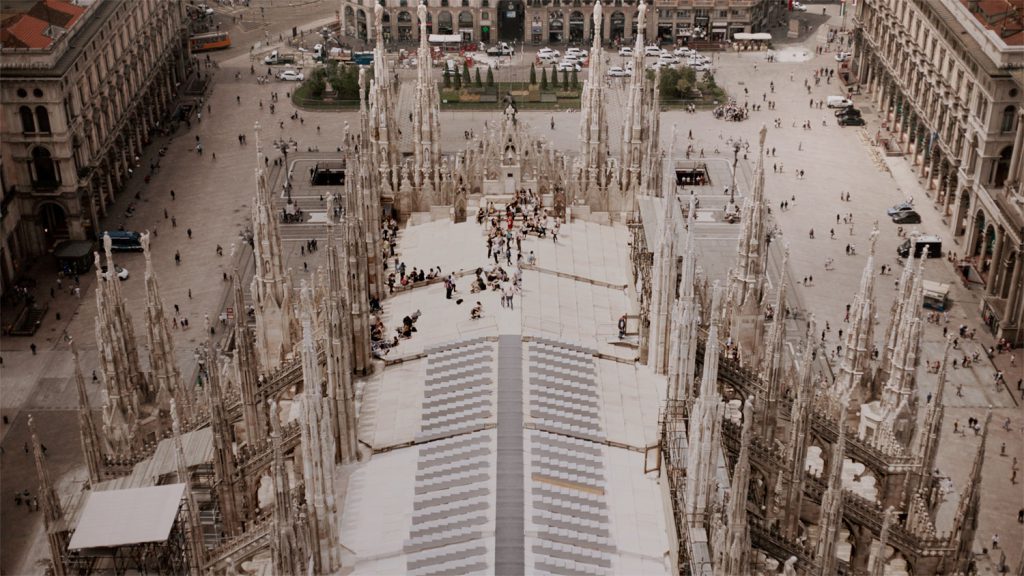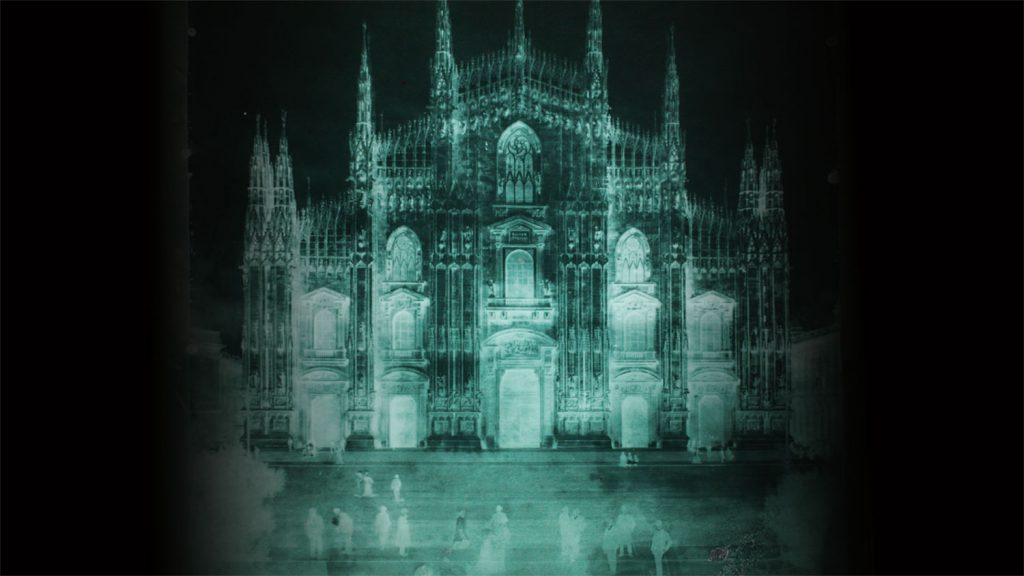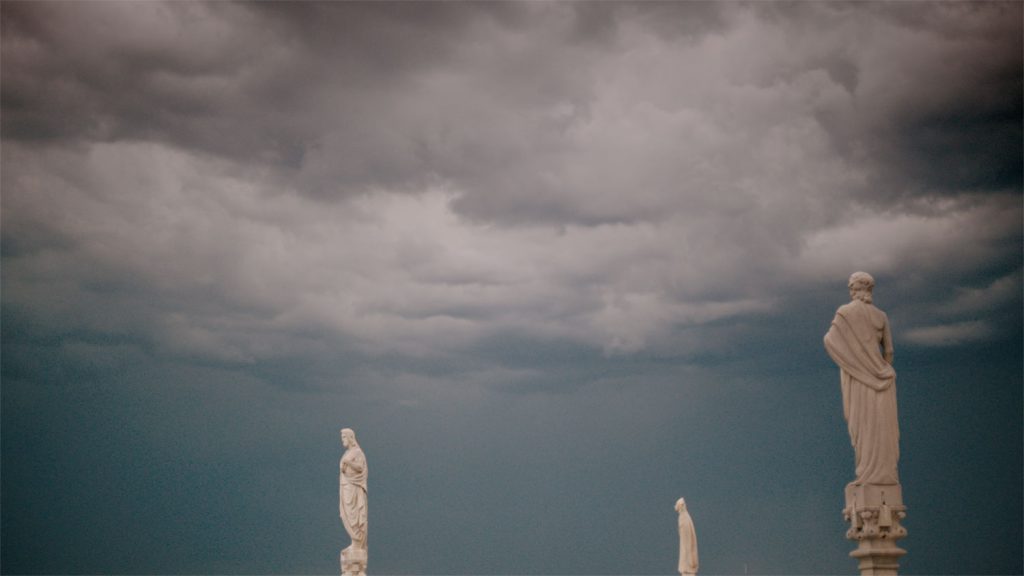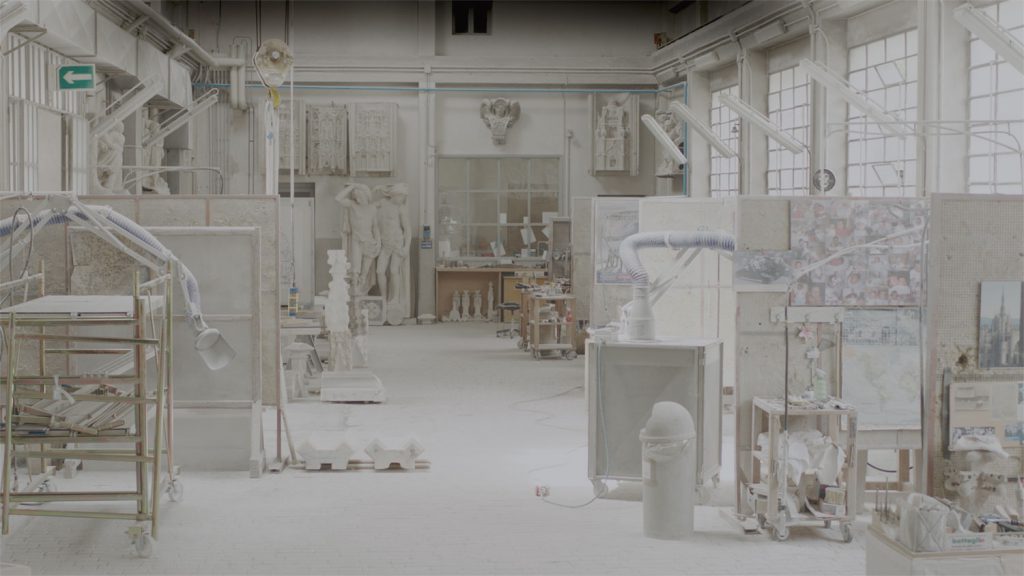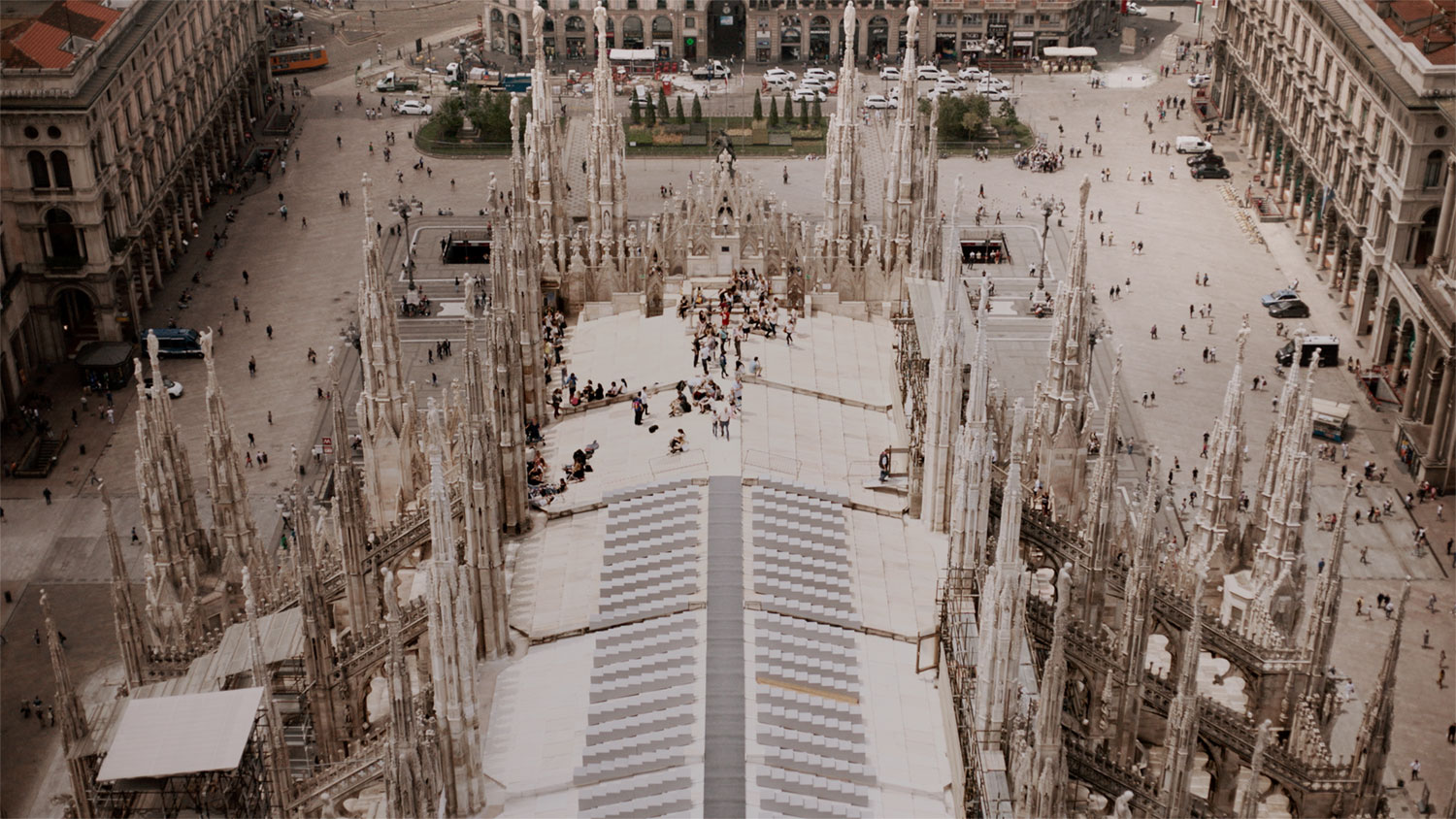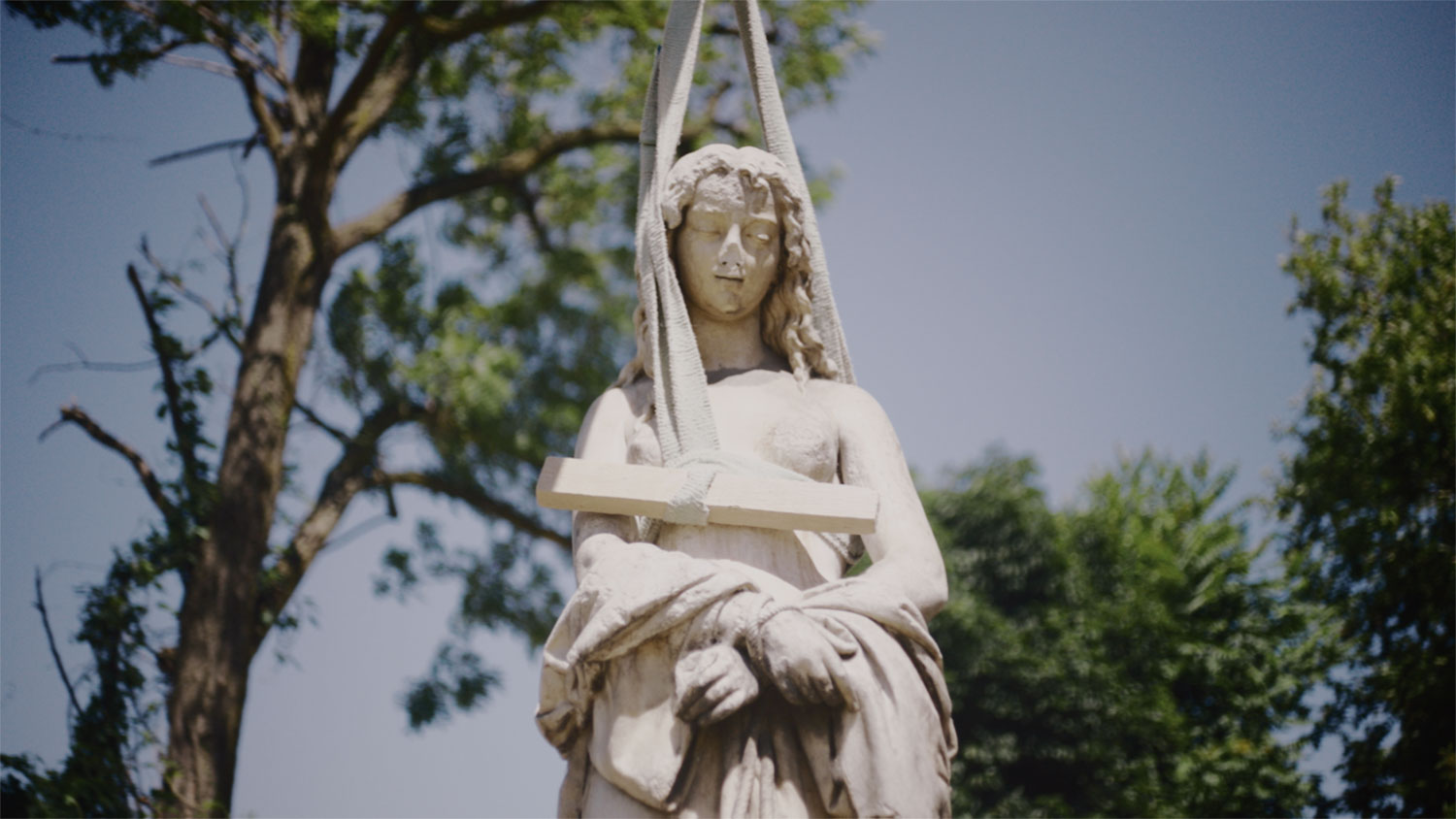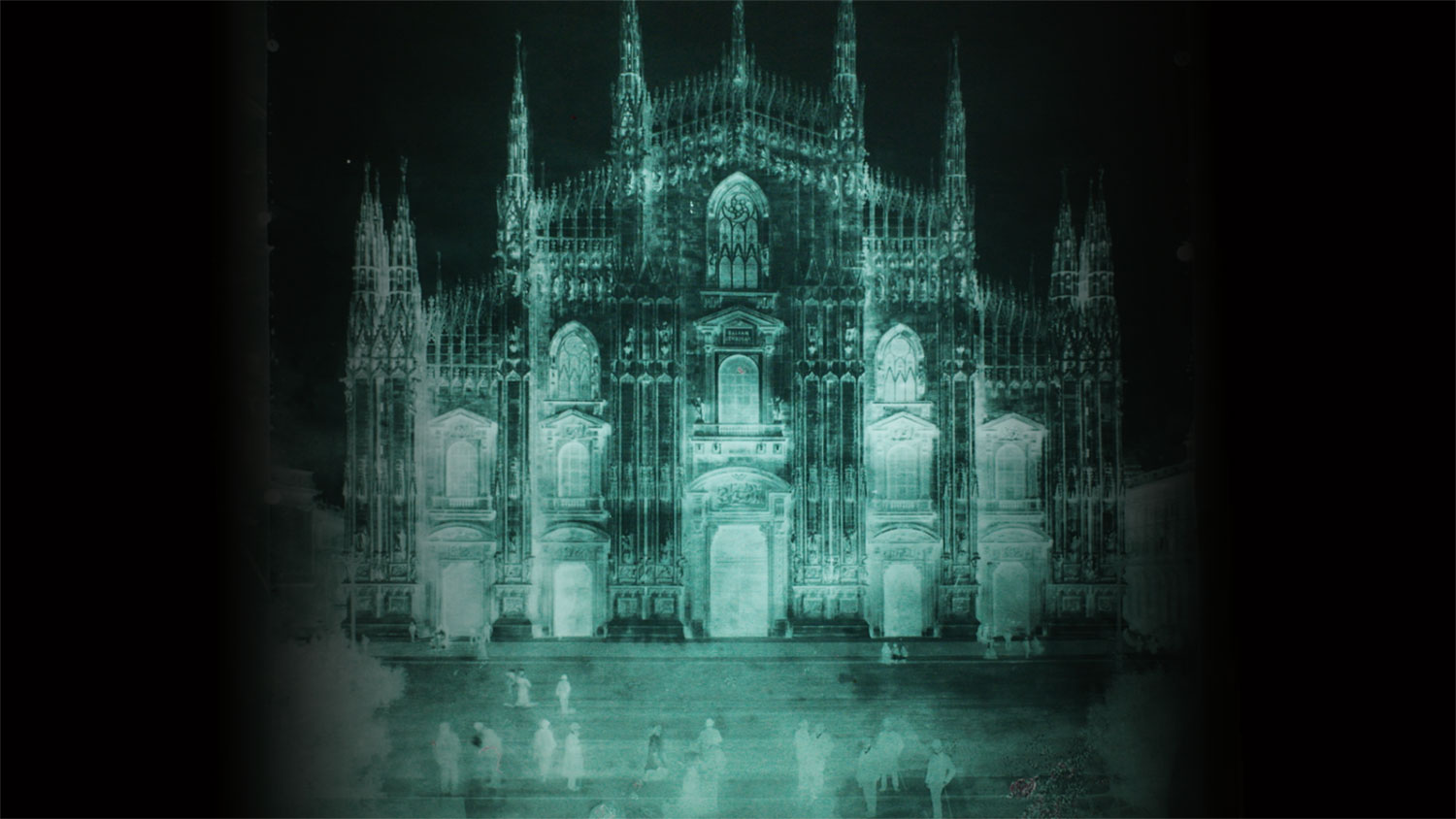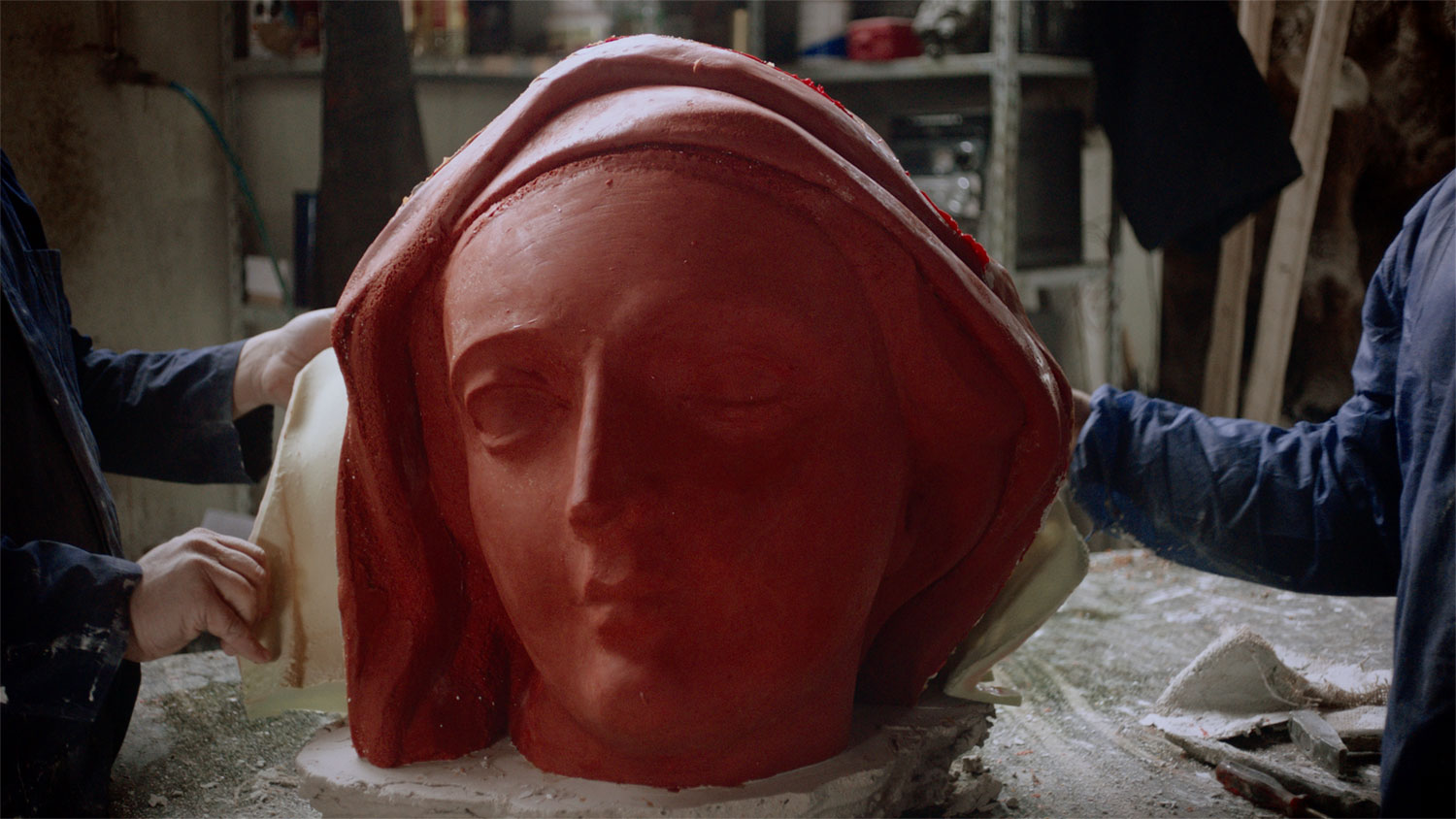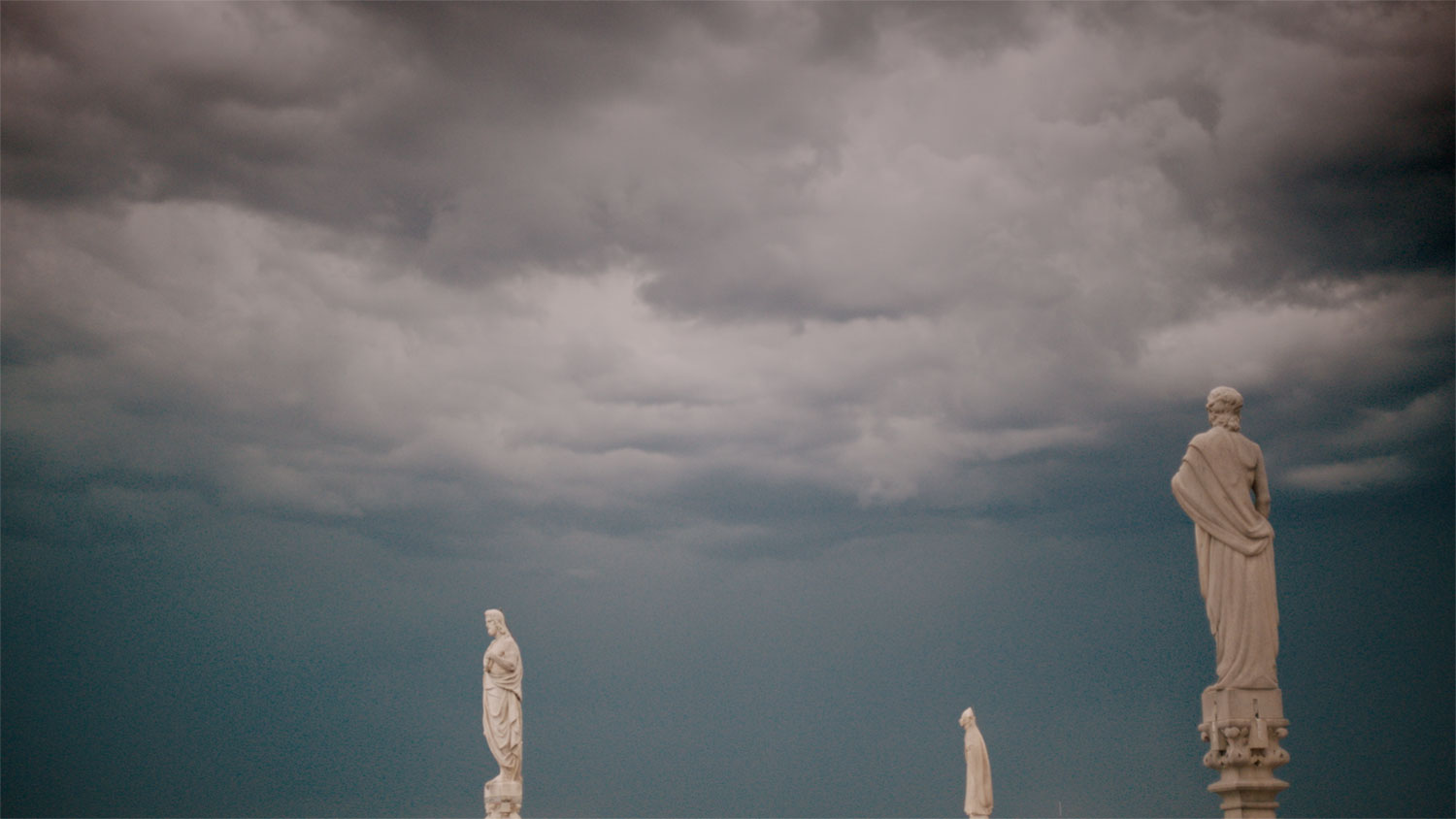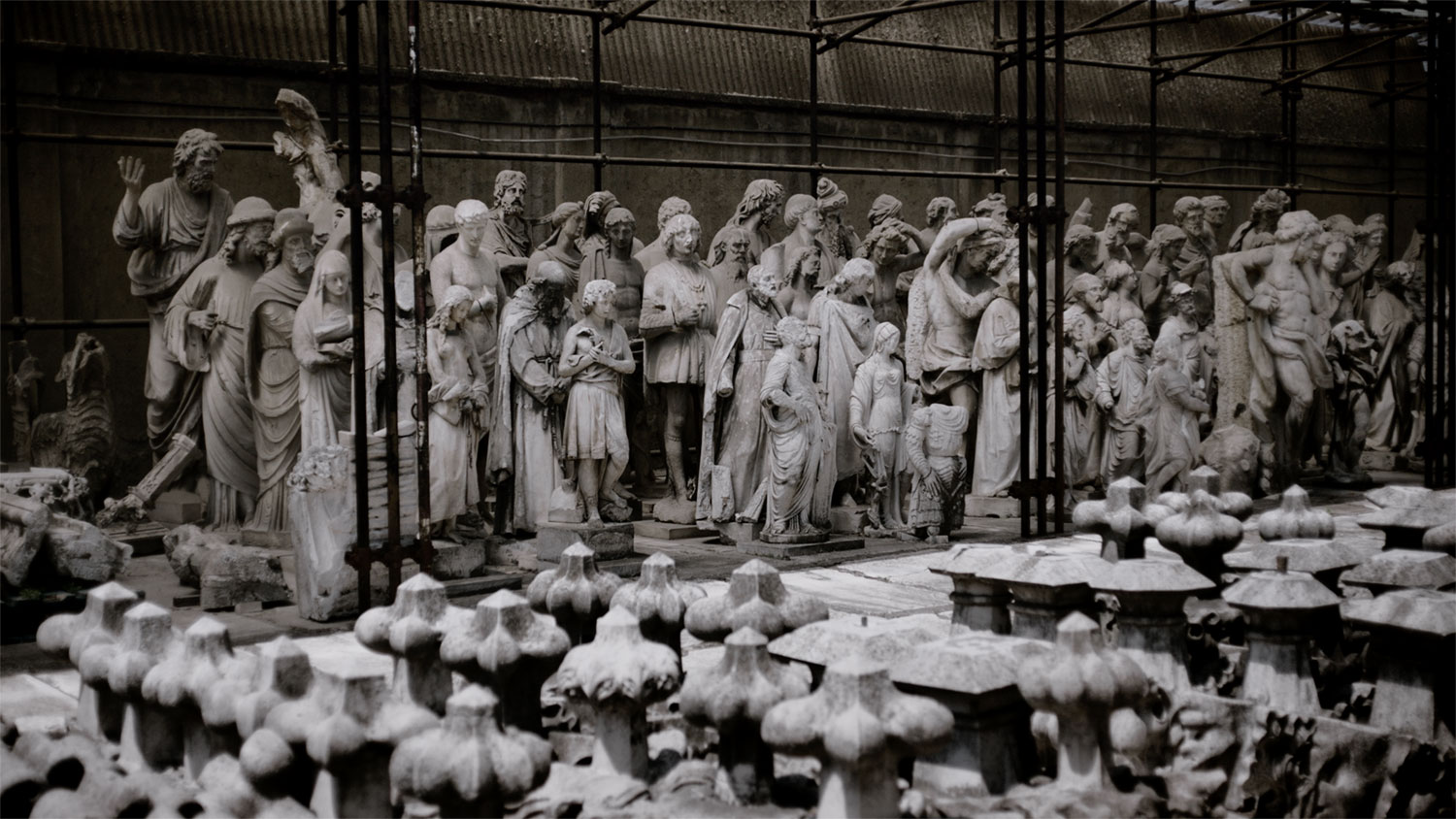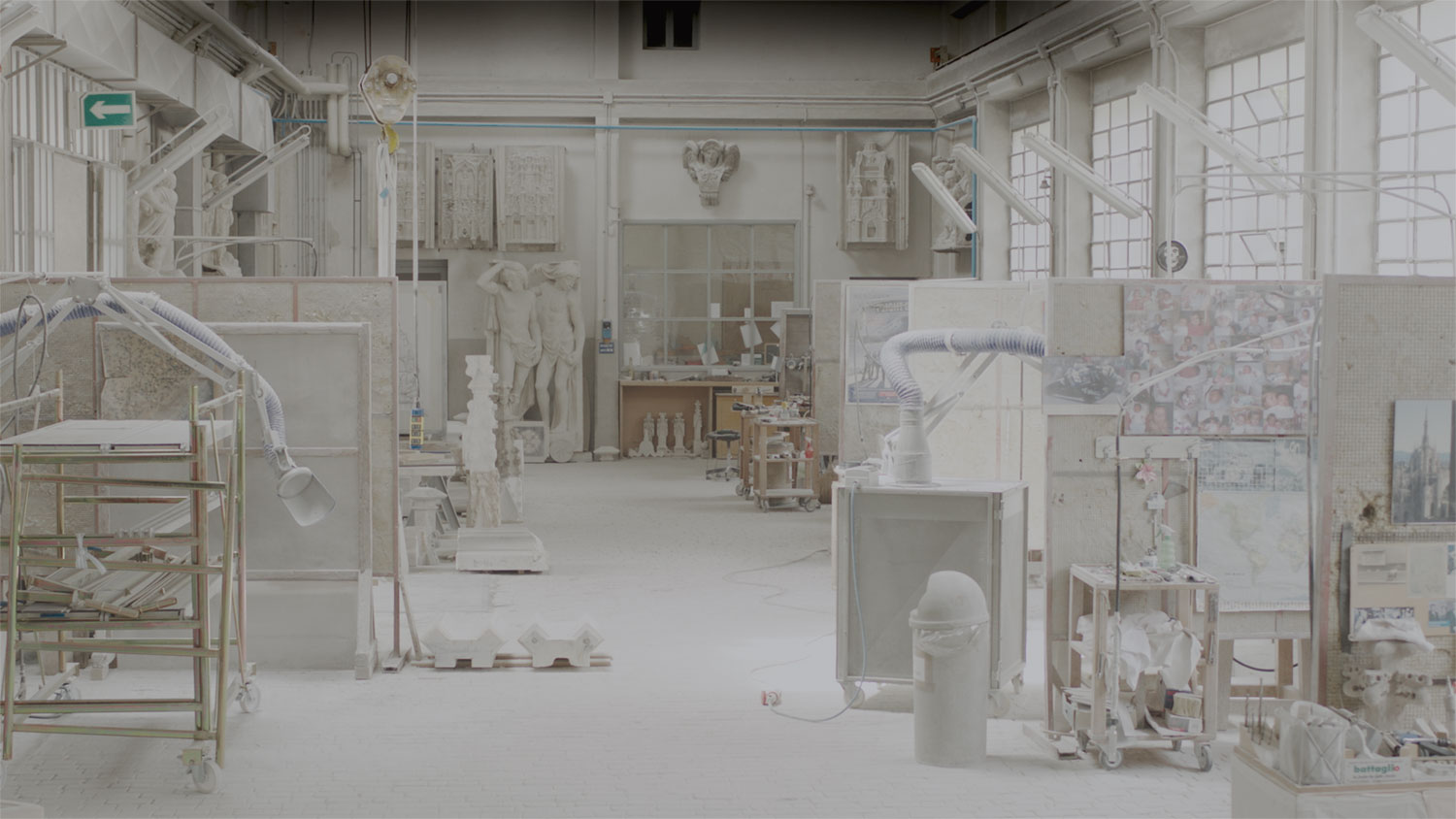Pour la Biennale de l’Image en Mouvement 2016, vous présentez notamment Spira Mirabilis,1 un film en cinq mouvements sur le thème de l’immortalité, qui vous a conduit à tourner aux quatre coins du monde : au Japon, en Suisse, au Dakota du Sud et en Italie. Je souhaiterais évoquer avec vous la genèse de cet ambitieux projet.
Spira Mirabilis est un projet que nous avons initié en 2013 et qui reprend notre démarche habituelle consistant à entreprendre un nouveau film là où s’achève le précédent. Materia oscura (2013) se conclut avec la mort, en s’interrogeant sur la stupidité de l’homme et sur sa tendance à se nuire. Il s’agissait d’un documentaire axé sur le polygone expérimental de Salto di Quirra en Sardaigne. Pendant un demi-siècle, Italiens, Européens, Américains, Libyens et Chinois ont exploité ce centre de tir militaire pour tester les armes du futur. C’est également là que de nombreux armements de la Seconde Guerre mondiale ont été explosés volontairement, entraînant une contamination dévastatrice de la région. Ce film propose un nouveau regard sur le conflit entre le pouvoir et les individus et prolonge la réflexion de nos réalisations antérieures. La mélancolie que nous avons ressentie en travaillant sur ce projet nous a poussés à réaliser un film nous permettant de nous libérer du conflit. C’est sur la base de ce postulat qu’a pris naissance Spira Mirabilis. La lecture d’un article du New York Times évoquant une méduse immortelle observée par un chercheur japonais en a constitué le déclic. Désireux de rencontrer ce scientifique, nous nous sommes rendus, durant l’été 2013, au Japon où nous avons immédiatement commencé à tourner des images, qui se sont révélées être magnifiques et très évocatrices, tout en étant conscients que nous ne pourrions pas faire un film uniquement sur ce sujet. A notre retour, nous nous sommes demandé comment nous pourrions aborder le thème de l’immortalité. Nous avons pensé aux quatre éléments symboliques de la nature et, par association, nous avons sélectionné des situations révélant des signes positifs communs à l’égard du genre humain. Aux antipodes de Materia oscura, nous voulions faire un film qui illustre une dimension grandiose de l’humanité, à travers des personnages constamment et obstinément en quête de constructions appelées à les enrichir, eux-mêmes et les autres.
FP : Pourtant, il me semble que cet élément de conflit rejaillit dans l’un des épisodes, notamment dans celui qui est lié au feu, dans lequel vous avez filmé les rituels d’une communauté d’Indiens Lakotas.
MDA et MP : En réalité, le conflit est présent dans tous les mouvements du film, mais cela n’est pas délibéré. Dans Spira Mirabilis, l’antagonisme se déplace de la confrontation entre l’homme et les institutions, qu’il a lui-même créées, vers un conflit intérieur. Dans nos histoires, cette tension motivée par la quête de l’immortalité s’incarne dans la science, dans la religion – à travers l’édification de grandes cathédrales –, dans l’art – par la fabrication d’instruments de musique très particuliers – et, également, dans quelque chose de plus mystérieux, lié à une intuition d’unité du tout et de la nature, qui peut être observé dans la culture Lakota. Dans l’ensemble de ces manifestations le conflit intérieur est permanent.
FP : Nous pourrions peut-être formuler l’hypothèse selon laquelle vous êtes passés de la dimension du conflit à celle du défi.
MDA et MP : Avec nos films, nous engageons toujours une lutte, à laquelle s’ajoute la volonté de nous mettre en danger. Avec le polygone expérimental de Salto di Quirra, nous avons eu l’impression que notre recherche sur le conflit était arrivée à un point de non-retour. Un film comme Spira Mirabilis représente un défi plus complexe. En effet, le cinéma se nourrit toujours de conflits, car d’une manière générale, les histoires s’appuient sur des hostilités consubstantielles à la dramaturgie. En ce qui nous concerne, nous nous efforçons d’explorer toujours plus le cinéma parce que son potentiel est encore en grande partie inexploré. Occulter un élément aussi important que la contestation sociale nous contraint à restreindre les possibilités du récit. Une autre différence réside dans le fait que dans nos autres films nous avions une réalité intrinsèquement forte qui a dû être interprétée, alors que dans Spira Mirabilis le procédé est inverse : c’est l’exploration d’une pensée perçue au travers de situations réelles. En revanche, même si nos documentaires sont formellement tournés à l’aide d’une caméra fixée sur trépied, avec des prises de vue très élaborées, il n’en reste pas moins que la continuité de notre travail s’affirme comme profondément sentimentale. Ce sont les émotions qui nous lient aux lieux et aux personnages que nous filmons, en tournant la caméra vers l’extérieur, mais surtout vers l’intérieur. Avec ce dernier film, notre démarche devient encore plus sentimentale.
FP : Nous pourrions le définir comme un éloge.
MDA et MP : C’est une sorte de symphonie du travail. Une très grande partie du film montre des mains affairées et appliquées à forger ou tailler la pierre ou encore à pratiquer des rituels Lakotas. Nous pourrions plus précisément affirmer qu’il s’agit-là d’un éloge du savoir-faire manuel et artisanal ancestral.
FP : Jusqu’à présent vous n’avez réalisé que des documentaires, mais nous avons le sentiment que dans ce dernier film vous vous confrontez de manière plus directe avec l’histoire du cinéma. Vous introduisez de nouvelles propositions formelles, implicites avec l’apparition de Marina Vlady, une actrice symboliquement forte, ou bien dans le travail sur le texte littéraire de Borges. Je souhaiterais vous demander d’ajouter quelques mots sur votre rapport à l’histoire du cinéma.
MDA et MP : Nous sommes deux cinéphiles qui nous sommes formés en visionnant autant de films que possible des débuts de l’histoire du cinéma à nos jours. C’est une chose que nous faisons peut-être un peu moins depuis que nous avons nos deux enfants, mais qui reste fondamentale dans notre éducation et dans notre vie quotidienne. Il se trouve que la pratique du film documentaire a été la formule la plus conforme à nos personnalités et à notre manière de faire. Nous aimons pratiquer le cinéma comme cela, seuls et de manière artisanale, sans renier pour autant les grosses productions. Nous admirons Ernst Lubitsch et Billy Wilder et nous sommes conscients de la manière particulière dont ils abordent le cinéma. En fait, nous nous considérons comme des artisans faisant recours à une méthode qui nous est propre et qui correspond aux films que nous réalisons. Ceci dit, notre méthode s’affine et notre ambition augmente d’un projet à l’autre. L’utilisation du texte de Borges et le recours à une actrice célèbre, qui renvoient à un autre cinéma, sont les témoins de ce changement. Notre démarche s’est également distinguée dans le traitement d’autres éléments. Nous nous éloignons du récit d’une réalité, mais c’est alors cette réalité qui s’impose pour représenter une pensée et un désir. Ceci témoigne de notre conviction que le cinéma peut prendre la forme d’un dispositif analytique, au sein duquel les images trouvent une deuxième vie. Notre travail se nourrit de la réalité, sans vouloir s’y substituer. Spira Mirabilis a justement pour point de départ le désir de raconter un imaginaire en s’appuyant sur des éléments tangibles. En cela, le réel est en quelque sorte annulé par l’acte même de filmer. Nous partons systématiquement du réel pour découvrir l’imaginaire, ainsi que de nouvelles façons de capter et de voir la réalité, afin d’ouvrir la voie à de nouvelles façons de faire du cinéma, cela, même si, en regardant certains films des années vingt, nous avons découvert de nombreuses similitudes entre la méthode que nous nous sommes appropriée et le cinéma de cette époque. L’important est d’exalter le langage, de concevoir un cinéma capable d’explorer les possibilités nouvelles de sa propre évolution qui, pour nous, devrait cohabiter avec une forme de mystère. N’oublions pas, autant pour nous que pour les autres, qu’aucun documentaire ne représente la réalité.
FP : Pour vous, le cinéma est par conséquent un instrument servant à révéler un objet autre, non tangible, quand bien même il serait réel.
MDA et MP : Les choses existent dans les yeux de ceux qui les regardent. Non seulement le cinéma, mais la vie elle-même a pour nous quelque chose de l’ordre du mystère. Toute forme d’art doit tenir compte de ce que l’univers renferme de plus obscur et de plus caché. Ce sont ces zones que nous tentons de sonder dans nos réalisations, car si la réalité ne sous-entend pas le mystère, elle se dissout et, parallèlement, le mystère qui délaisse la réalité peut devenir très dangereux. En fait, ces deux pôles opposés devraient toujours dialoguer et ce qui, précisément, nous intéresse, c’est faire se rencontrer mystère et réalité au sein de cette interface.
Traduit de l’italien par Anne-Catherine Caron
- Spira Mirabilis sera présenté à l’occasion du finissage de la Biennale de l’Image en Mouvement, fin janvier 2017, en exclusivité avant sa sortie en salles.

